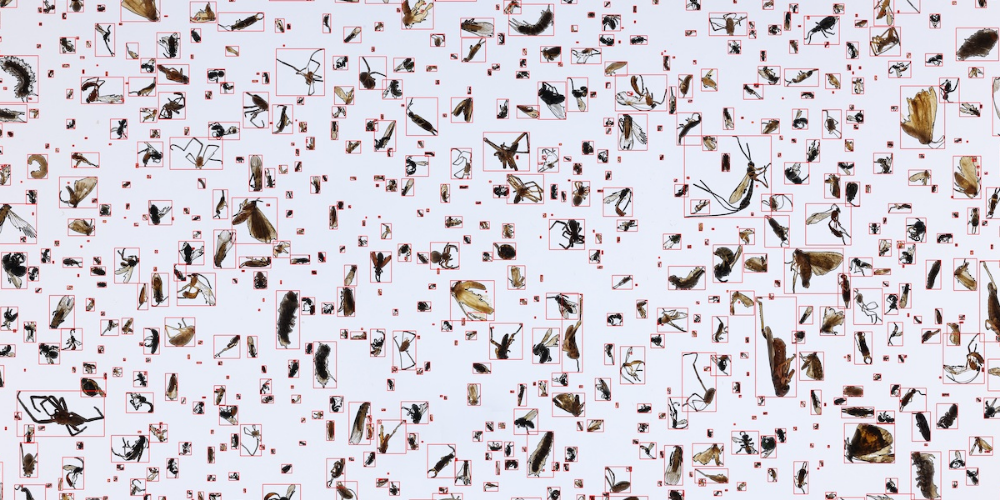A University of Guelph research team has designed a much faster way to measure the increases and declines in biodiversity within an environment by analyzing bulk insect samples using digital photography and artificial intelligence (AI).
Insect populations can tell us a lot about the health of an ecosystem and the state of its biodiversity.
Unlike the traditional method of counting bulk samples by hand and classifying each bug using a microscope, the new approach, known as BugShot, captures a high-resolution photograph of a sample and uses deep learning computer vision AI to rapidly identify each insect in samples that can exceed 1,000 bugs.
The researchers estimate that the new approach could shorten the process from roughly a year using traditional methods to an hour or two using BugShot.
The aim of the research is to find a better way to assess biodiversity gain from habitat restoration in the agri-food sector. However, it has broader conservation applications, said Dr. John Fryxell, an international expert in how changes to the environment and organism behaviour affect the consumer-resource dynamic.
Published recently in Methods of Ecology and Evolution, the study demonstrates how AI can perform the taxa classification of bugs and how to scale up the process for use in the lab.
Data vital to understanding changes in biodiversity
“The key thing about what we’ve done with this approach is we’ve opened up the window to getting additional information that is vital for assessing the underlying causes of changes to biodiversity,” said Fryxell, a professor in the College of Biological Science. He collaborated on the study with College of Engineering and Physical Sciences post-doctoral researcher Dr. Stefan Schneider as well as Dr. Graham Taylor, School of Engineering, and Dr. Stefan Kremer, School of Computer Science.
Molecular techniques tell us what species live in an ecosystem but not how many there are, what size they are or what roles they play ecologically, said Fryxell. Such data are vital for understanding the ecological triggers responsible for biodiversity loss and for implementing effective remediation efforts, he said.
Schneider said insect counts are used as a measure of biodiversity improvement or decline, but the conventional way of counting is labour-intensive and time-consuming. BugShot can remove the bottleneck from the data collection process and get much more rapid results.
“There is a trend of diversity decline in arthropods across the world and there has been an effort to document this in whatever way we can,” he said.
Traditionally, ecologists use malaise traps, or large tent-like structures, to capture insects. Whatever crawls into the trap is collected, stored in an ethanol bath and transported to a laboratory. There, a lab technician looks at each individual specimen under a microscope to determine exactly what it is.
Rapid species identification compared to traditional method
“It’s quite labour-intensive to sit there with a pair of tweezers and a microscope, going through these one at a time,” Schneider said. “With our technique, we take that jar of bugs, dump it on a white sheet or into a petri dish and take a high-resolution photograph of it. With a single click of the camera, the modern AI methods that we built and trained perform taxa classifications of however many bugs there are in the photo.”
The AI traces the pixel contours within the photographic image, turning it into a kind of topographical map. Regions of the map are isolated and deep learning algorithms perform computations that classify the bugs.
“It gives us a much better measuring stick for actually getting a handle on what is going on in an ecosystem,” Schneider said. “It becomes a very robust tool.”
He said ongoing efforts by researchers at U of G to carry out bug-counting work resulted in an extensive collection of jars containing a single insect species. The jars proved indispensable in training the AI model, showing the tool examples of insects to ensure accurate identification when various insects are lumped together in a large sample.
Fryxell said the tool will allow ecologists to save valuable time in the process of understanding the ups and downs of biodiversity.
“Ecologists spend most of their lives doing very tedious, difficult and unpleasant tasks, all in the name of understanding nature,” he said. “It’s wonderful to come up with a labour-saving technique that gives us the chance to really count things efficiently. I think we’re on the verge of that.”
The research was funded under the auspices of U of G’s Food from Thought: Agricultural Systems for a Healthy Planet research program, specifically $160,000 from the program’s digital agriculture theme. The goal of the program is to increase the sustainability and productivity of global food production using data science, agri-food research and biodiversity science.
Contact:
Dr. John Fryxell
jfryxell@uoguelph.ca
Dr. Stefan Schneider
sschne01@uoguelph.ca


